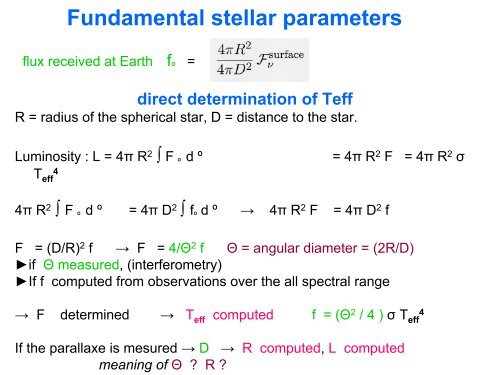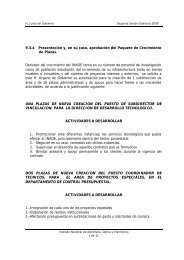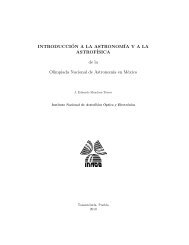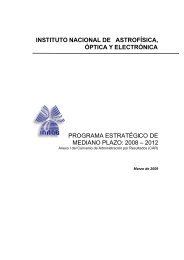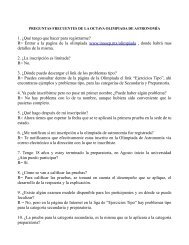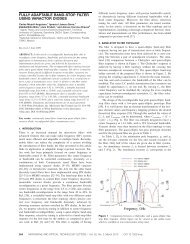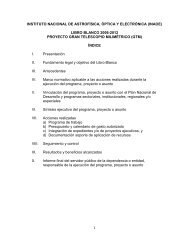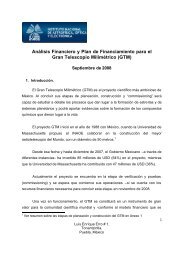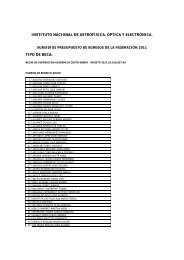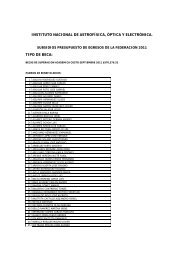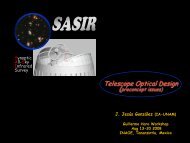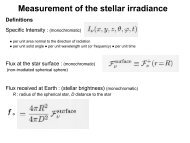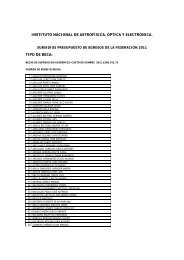Part C - inaoe
Part C - inaoe
Part C - inaoe
Create successful ePaper yourself
Turn your PDF publications into a flip-book with our unique Google optimized e-Paper software.
Fundamental stellar parameters<br />
flux received at Earth f º =<br />
direct determination of Teff<br />
R = radius of the spherical star, D = distance to the star.<br />
Luminosity : L = 4π R 2 ∫ F º dº<br />
T eff<br />
4<br />
= 4π R 2 F = 4π R 2 σ<br />
4π R 2 ∫ F º dº = 4π D 2 ∫ f º dº → 4π R 2 F = 4π D 2 f<br />
F = (D/R) 2 f → F = 4/Θ 2 f Θ = angular diameter = (2R/D)<br />
►if Θ measured, (interferometry)<br />
►If f computed from observations over the all spectral range<br />
→ F determined → T eff computed f = (Θ 2 / 4 ) σ T eff<br />
4<br />
If the parallaxe is mesured → D → R computed, L computed<br />
meaning of Θ ? R ?
seminal paper : Code et al. 1976, ApJ, 203, 417<br />
32 stars O5 – F8 : SED measured<br />
angular diameter from interferometry ( at ~440 nm)<br />
Hanbury-Brown et al 1974, MNRAS, 167, 121<br />
accuraccy rely upon :<br />
♦ measurements of flux, angular diameters<br />
♦ model of interstellar redenning to correct the observations<br />
♦ atmosphere model :<br />
to correct the missing flux at short wavelength (less than 110 nm)<br />
to correct for line blocking (energy mesured in « continuum » windows)<br />
∆ Teff / Teff = ∆ f / (4 f ) + ∆Θ / (2 Θ )<br />
(an accuracy of 2% on Θ is needed for an error of 1% on Teff)<br />
difficult to apply this method to a large set of stars<br />
measurements of angular diameters still limited ( interferometry )<br />
→ alternative method to interferometry to determine the angular diameter<br />
IRFM (infra-red flux method)
Davis, 1997, IAU Symposium 189, 31.
Infrared Flux Method : IRFM<br />
Blackwell & Shallis (1977, MNRAS, 180,177)<br />
based on Gray D. 1967, 1968 ApJ 149,317; AJ 73, 769<br />
(1) σ T eff4<br />
=(4 / Θ 2 ) f<br />
(2) F λ<br />
= (4 / Θ 2 ) f λ<br />
spectral domain in the infrared<br />
to derive (Θ and T eff<br />
) to satisfy (1) and (2) iterative method.<br />
based on assumption, valid : the flux in the infra-red has a weak dependance on Teff.<br />
SED, f λ<br />
observed, F λ<br />
given by a model, but low dependance on the model.<br />
♦ not applicable to “exotic” star<br />
♦ rely on accurate flux calibration in the IR<br />
♦ uncertainty due to the de-reddening to compute f<br />
an error on E(B-V) of 0.02mag gives 1 to 5% on Teff<br />
♦ unsuitable for hot stars (above 10000K)<br />
lack of UV flux measured.<br />
for Teff ~25000K 20% of the flux is emitted at < 110 nm<br />
discussion of the accuraccy :<br />
Blackwell et al, 1979 MNRAS, 188, 847<br />
Brooth, 1997, Symposium 189, 147; Megessier , 1997, Symposium 189, 153<br />
a « few » % on all the required parameters<br />
too few « fundamental » values, specially θ , for real testing (the Code’s stars)
2 = equation (1)<br />
3 = equation (2)<br />
Blackwell et al 1979, MNRAS, 188,847<br />
Blackwell & Shallis 1977, MNRAS, 180, 177<br />
(angular diameter in arcsec)
Alternative method (Blackwell et al 1980, A&A, 82, 249)<br />
(1) σ T eff4 =(4 / Θ 2 ) f<br />
(2) F λ = (4 / Θ 2 ) f λ → σ T eff4 = (F λ / f λ ) f<br />
σ T<br />
4<br />
eff = F λ R<br />
with R = f / f λ<br />
F λ given by a model, λ is in the infrared domain.<br />
R computed from a grid of models : R = σ T<br />
4<br />
eff / F λ<br />
→ a grid R ( Teff, log g, λ, Fe/H)<br />
the measure quantity : f / f λ is compared to R computed → Teff<br />
by product : θ<br />
accuraccy : roughly of 2.5% in Teff for star later than A5, and ~6% for Θ.<br />
Needs good calibration of the IR and good energy distribution over λ; results influenced<br />
by the atmosphere model and log g and Fe/H of the star (has to be known!)<br />
Publications in the 90’s : (...Blackwell… 1986, A&A, 159,217; 1994, A&A, 282, 899; 1998, A&AS,<br />
129, 505)<br />
Discussion of the accuracy of the method, impact of the atmosphere model : Megessier 1994,<br />
A&A, 289, 202; 1997, Symposium 189, 153.<br />
IRFM : Teff accurate if log g anf Fe/H also known; rely upon IR calibration<br />
best domain : stars cooler than F0 (most of the flux emitted in the visible)<br />
Note:<br />
several Teff can be determined if several λ in the IR are used, increased the accuracy.<br />
IRFM is closed to a color-index determination of Teff, one « filter » cover the all range
Extension of the IRFM<br />
Application of the IRFM to a large sample of F0-K5 dwarfs and giants.<br />
Alonso et al, 1996, A&AS, 117, 227 (F0V – K5V);<br />
1999, A&AS, 139, 335 (F0-K5 giant) (and ref. in it)<br />
→ Teff determination for ~500 dwarfs and ~500 giants<br />
3500K ≤ Teff ≤ 8000K; -3.0 ≤ [Fe/H] ≤ +0.5; 0.5 ≤ log g ≤ 5<br />
(Alonso et al. 1994, A&A, 282,684: calibrate the IR flux using stars with direct measures of their<br />
angular diameter)<br />
♦Bolometric fluxes (SED) from broad-band photometry (its calibration taking into<br />
account Fe/H effects) and bolometric correction<br />
♦ Kurucz (1993) model atmosphere.<br />
♦ Detailed analysis of the uncertainties coming from each step of computation<br />
♦ IR photometry (broad-band), its calibration, IR monochromatic fluxes<br />
♦ Reddening correction<br />
♦ Determination of log g (low sensitivity to g for dwarf stars log g = 5 for the cooler, and 4 for hottest; for the<br />
giant log g =2 or from litterature) and Fe/H from other calibrations<br />
Internal error on Teff ~1-2 %<br />
Comparison with other determinations : not many « direct » determination of Teff<br />
Comparison of the mean Teff of solar analogue star to that of the Sun 5743 ± 100K<br />
compared to 5780K.
Alonso, 1996, A&AS, 117, 227
Alonso et al, 1999, A&AS139, 335
outine to determine Teff with such method not in the public domain due<br />
to the numerous “correcting” steps needed to apply it; keep the internal<br />
consistency of these results.<br />
→ calibration of color indices in term of Teff, [Fe/H]<br />
for the dwarf F0V – K5V : (B-V), (R-I), (V-R), (V-I), (V-K), (J-H), (J-K), β<br />
for the giant F0 – K5 : (U-V), (B-V), (R-I), (V-R), (V-I), (V-K), (J-H), (J-K),<br />
(I-K), (V-L’), (b-y), (u-b)<br />
using the IRFM determinations of Teff<br />
Alonso et al 1996, A&A, 313, 873; 1999, A&AS, 140, 261.<br />
log g , [Fe/H] not explicitly taken into account but :<br />
♦ gravity effect on calibration of (B-V), (V-R), (V-I), (J-H), (J-K)<br />
♦ negligible dependance on gravity for (R-I), (V-K)<br />
♦ for giant stars non-dependance on metallicity for (V-I), (I-K), (J-K)<br />
Extensive comparison with previous work of Teff determination including theoretical<br />
calibration.<br />
(±0.1 dex on [Fe/H] → ±0.1 5% on Teff)
Alonso et al, 1996, A&A, 313, 873 (F0V – K5V)
Angular diameters from IRFM<br />
by-product<br />
σ T eff4 =(4 / Θ 2 ) f → determination of the angular diameter Θ<br />
compared to that determined by interferometric technics<br />
for giant stars F0-K5 domain, (with internal error below 5%)<br />
↔ to compare the « IRFM » Teff with « direct » Teff<br />
Alonso et al, 2000, A&A, 355,1060<br />
no systematic differences → no « zero point »correction for the Teff scale<br />
But:<br />
direct angular diameter Θ determination may be affected by limb<br />
darkening corrections and/or possible circumstellar dust shells giving<br />
larger Θ; circumstellar dust shells may also affect IRFM via the SED<br />
If parallaxe mesured → mean radius values computed<br />
(for solar metallicity stars)<br />
note : trend of the radius according to the metallicity<br />
(R = Θ(D/2). error on parallaxes: 2-20%, expected error on Θ →error on radius 5-27%)
Effective temperature scale for FGK stars<br />
dwarf and giant<br />
Extension of Alonso et al Teff calibration by Ramírez & Meléndez<br />
(2005, ApJ, 626, 446, ApJ,626,465)<br />
3600K ≤ Teff ≤ 8000K -4.0 ≤ Fe/H] ≤ +0.5<br />
Consistency checked with angular diameters by interferometry and lunar<br />
occultation and transit<br />
Updated and extension of the previous calibration of photometric indices<br />
UBV, uvby, Vilnius, Geneva, RI (Cousins), DDO, Tycho, 2MASS<br />
→ for the very metal-poor dwarf star, (V-K) is not completely metallicity independent<br />
(if IRFM Teff is realiable for these stars)
….Teff of cooler stars ?<br />
molecules and dust in the stellar atmosphere complicate greatly any<br />
modelisation<br />
for dwarf M, L, T type stars, no Θ measured through interferometry,<br />
→ no direct Teff mesured (yet)<br />
Teff and absolute magnitude determined from theoretical color indices<br />
computed from model atmosphere<br />
→ subject in continuous evolution<br />
e.g. Jones et al. 1996, MNRAS, 280, 77; Leggett et al 2002, ApJ, 564, 452;<br />
Burrows et al, 2003, ApJ, 596, 587; Dahn et al. 2002, AJ, 124,1170.
for giant K and M type stars Θ measured through interferometry, Teff<br />
computed with IRFM<br />
give the basis for a direct determination of Teff<br />
(e.g. Dyck et al, 1996, AJ, 111, 1705)<br />
IRFM method affected by the strong molecular bands in the IR<br />
→ define « continuum » region<br />
→ bolometric correction difficult to compute (strong absorption bands,<br />
large variation with Teff)<br />
measure of Θ affected by circumstellar dust shells: this dust is difficult<br />
to separe from the photospheric radiation (e.g. van Belle et al 1999, AJ,<br />
117, 521)<br />
Calibration in Teff of color indices UBV, RI(Cousins), JHK<br />
(e.g. Houdashelt et al. 2000, AJ, 119, 1424)
Theoretical colors, Bolometric Corrections<br />
and colors versus Teff relations<br />
from stellar atmosphere models<br />
→ theoretical colors for any photometric system<br />
synthetic photometry<br />
→ produce extended grids of Teff calibration over extended ranges of<br />
Teff, log g and [Fe/H] which represend real photometric systems<br />
(if « zero point » carrefully determined)<br />
Hints : the passband sensitivity functions of a photometric system<br />
may vary … and the one used in the computations<br />
may not represent any real system
these grids can be used only with de-reddenned observed colors;<br />
log g, [Fe/H] must be known.<br />
■ Bessell, Castelli & Plez, 1998, A&A 333, 231 UBVRIJHKL<br />
O-M stars Teff versus : (BCP98)<br />
(U-B) B0-A0 dwarfs; (V-K) A-G dwarfs; (V-I) A-M dwarfs; (I-K) M dwarfs; (V-K) G-M giants<br />
■ Bessell, 2001, PASP, 113, 66 Washington system<br />
6000K ≤ Teff ≤ 40000K log g : 2.0 – 5.0<br />
3000K ≤ Teff ≤ 550K log g : -0.5 – 5.0 [Fe/H] -3 to +0.3<br />
■ Houdashelt & Bell, 2000, AJ, 119, 1448 UBVRIJHK<br />
F-K stars Teff versus colors<br />
Cousins, Johnson-Glass, CIT/CTIO systems calibrated with IRFM<br />
4000 K ≤ Teff ≤ 6500 K, 0.0 ≤ log g ≤ 4.5, and -3.0 ≤ [Fe/H] ≤ 0.0<br />
■ Clem et al, 2004, AJ, 127, 1227 Strömgren uvby : analysis of the correction to be added<br />
to the purely synthetic colors to satisfy various situations : globular clusters analysis etc.<br />
combination of color indices have been produced in order to<br />
determine from photometry log g, [Fe/H] and the reddenning.


